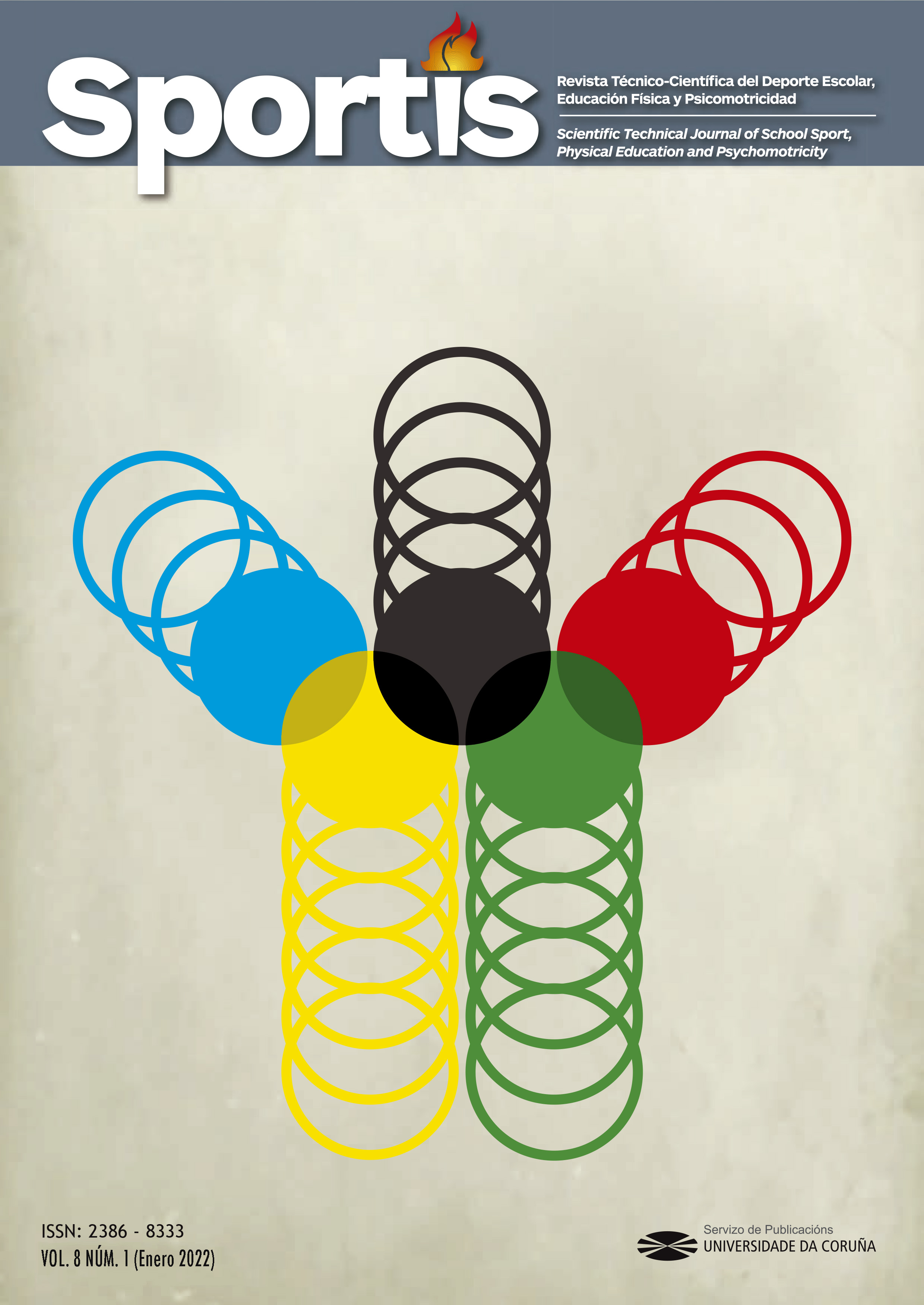Impacto de las redes sociales en el desarrollo profesional en Educación Física: usos, motivaciones y oportunidades
Contenido principal del artículo
Resumen
Las redes sociales surgieron como una herramienta de comunicación lúdica, sin embargo, pronto se empezaron a ver otras posibilidades, como el desarrollo profesional, en especial, en el ámbito educativo. La presente investigación tiene como objetivo conocer el impacto que generan las redes sociales en el desarrollo profesional de los docentes y estudiantes de Educación Física y comparar los distintos usos, motivaciones y oportunidades que ofrecen. Para ello se elaboró y se validó un cuestionario que fue respondido por 403 participantes. Los resultados indican que la red social más utilizada para el desarrollo profesional en el ámbito de la Educación Física es YouTube (3,39/5), seguida de Instagram (2,82/5) y Facebook (2,68/5); las principales motivaciones para su uso son el entretenimiento y la ayuda que ofrecen para el desarrollo profesional en la formación docente (36,6% ambos); asimismo, las redes sociales permiten iniciar nuevos proyectos (76,8%), como el desarrollo de unidades didácticas y/o programaciones o la participación en congresos.
Palabras clave:
Descargas
Detalles del artículo
Citas
Aguilera-Mata, R. y García-Martínez, S. (2021). Las redes sociales como herramienta de formación docente: reflexiones y experiencias personales. Revista Electrónica Transformar, 2(1), 30–40. https://revistatransformar.cl/index.php/transformar/issue/view/8/9
Alsuraihi, A. K., Almaqati, A. S., Abughanim, S. A. y Jastaniah, N. A. (2016). Use of social media in education among medical students in Saudi Arabia. Korean Journal of Medical Education, 28(4), 343–354. DOI: https://doi.org/10.3946/kjme.2016.40
Andrew, K., Killian, C. M., Kinder, C. J., Badshah, K. y Cushing, C. (2020). Chapter 4: Twitter as a professional development platform among U.S. Physical Education teachers. Journal of Teaching in Physical Education, 39(4), 454–463. DOI: https://doi.org/10.1123/JTPE.2020-0001
Armour, K., Quennerstedt, M., Chambers, F. y Makopoulou, K. (2015). What is ‘effective’ CPD for contemporary Physical Education teachers? A Deweyan framework. Sport, Education and Society, 22(7), 799–811. DOI: https://doi.org/10.1080/13573322.2015.1083000
Awidi, I. T., Paynter, M. y Vujosevic, T. (2019). Facebook group in the learning design of a higher education course: An analysis of factors influencing positive learning experience for students. Computers and Education, 129, 106–121. DOI: https://doi.org/10.1016/j.compedu.2018.10.018
Brooks, C. C. y McMullen, J. M. (2020). Chapter 5: Using social media: One Physical Education teacher’s experience. Journal of Teaching in Physical Education, 39(5), 464–471. DOI: https://doi.org/10.1123/JTPE.2020-0005
Carpenter, J. P. y Harvey, S. (2020). Chapter 2: Perceived benefits and challenges of Physical Educators’ use of social media for professional development and learning. Journal of Teaching in Physical Education, 39(2), 434–444. DOI: https://doi.org/10.1123/JTPE.2020-0002
Carpenter, J. P. y Krutka, D. G. (2014). How and why educators use Twitter: A survey of the field. Journal of Research on Technology in Education, 46(4), 414–434. DOI: https://doi.org/10.1080/15391523.2014.925701
Dopico, M. (2016). Estudio descriptivo sobre la formación inicial de los/as maestros y maestras de Educación Física escolar. Sportis. Scientific Journal of School Sport, Physical Education and Psychomotricity, 2(2), 188–205. DOI: https://doi.org/10.17979/sportis.2016.2.2.1429
Goodyear, V. A., Casey, A. y Kirk, D. (2014). Tweet me, message me, like me: using social media to facilitate pedagogical change within an emerging community of practice. Sport, Education and Society, 19(7), 927–943. DOI: https://doi.org/10.1080/13573322.2013.858624
Goodyear, V. A., Parker, M. y Casey, A. (2019). Social media and teacher professional learning communities. Physical Education & Sport Pedagogy, 24(5), 421–433. DOI: https://doi.org/10.1080/17408989.2019.1617263
Harvey, S. y Carpenter, J. P. (2020). Chapter 3: Genesis and change in Physical Educators’ use of social media for Professional Development and Learning. Journal of Teaching in Physical Education, 39(3), 445–453. DOI: https://doi.org/10.1123/jtpe.2019-0284
Harvey, S., Carpenter, J. P. y Hyndman, B. (2020). Chapter 1: Introduction to social media for Professional Development and Learning in Physical Education and Sport Pedagogy. Journal of Teaching in Physical Education, 39, 425–433. DOI: https://doi.org/10.1123/jtpe.2020-0004
Harvey, S. y Hyndman, B. (2018). An investigation into the reasons Physical Education professionals use Twitter. Journal of Teaching in Physical Education, 37(4), 383–396. DOI: https://doi.org/10.1123/jtpe.2017-0188
Hyndman, B. y Harvey, S. (2019). Health and Physical Education teacher education 2.0: Pre-service teachers’ perceptions on developing digital twitter skills. Australian Journal of Teacher Education, 44(2), 34–50. DOI: https://doi.org/10.14221/ajte.2018v44n2.3
IAB Spain. (2020). Estudio de Redes Sociales 2020. https://iabspain.es/estudio/estudio-redes-sociales-2020/
Infante Moro, A. y Aguaded Gómez, J. I. (2012). Las redes sociales como herramientas educativas. Las Tecnologías de La Información En Contextos Educativos: Nuevos Escenarios de Aprendizaje, 163–176.
Keay, J. K., Carse, N. y Jess, M. (2018). Understanding teachers as complex professional learners. Professional Development in Education, 45(1), 125–137. DOI: https://doi.org/10.1080/19415257.2018.1449004
Kenny, P. y Johnson, I. G. (2016). Social media use, attitudes, behaviours and perceptions of online professionalism amongst dental students. British Dental Journal, 221(10), 651–655. DOI: https://doi.org/10.1038/sj.bdj.2016.864
Kinchin, G. D. y Bryant, L. G. (2015). Using social media within Physical Education teacher education. Strategies, 28(5), 18–21. DOI: https://doi.org/10.1080/08924562.2015.1066284
Luo, T., Freeman, C. y Stefaniak, J. (2020). “Like, comment, and share”—professional development through social media in higher education: A systematic review. Education Tech Research, 68, 1659–1683. DOI: https://doi.org/10.1007/s11423-020-09790-5
Macià, M. y García, I. (2016). Informal online communities and networks as a source of teacher professional development: a review. Teaching and teacher education, 55, 291-307. DOI: https://doi.org/10.1016/j.tate.2016.01.021
Marín-Díaz, V. y Cabero-Almenara, J. (2019). Las redes sociales en educación: desde la innovación a la investigación educativa. RIED. Revista Iberoamericana de Educación a Distancia, 22(2), 25–33. DOI: https://doi.org/10.5944/ried.22.2.24248
McNamara, S., Healy, S. y Haegele, J. (2019). Use of social media for Professional Development by Physical Educators who teach Students with Disabilities. International Journal of Disability, Development and Education, 1–12. DOI: https://doi.org/10.1080/1034912X.2019.1699649
Schroeder, S., Curcio, R. y Lundgren, L. (2019). Expanding the Learning Network: How Teachers Use Pinterest. Journal of Research on Technology in Education, 51(2), 166–186. DOI: https://doi.org/10.1080/15391523.2019.1573354
Smith Risser, H. (2013). Virtual induction: A novice teacher’s use of Twitter to form an informal mentoring network. Teaching and Teacher Education, 35, 25–33. DOI: https://doi.org/10.1016/j.tate.2013.05.001
Trust, T., Krutka, D. G. y Carpenter, J. P. (2016). “Together we are better”: Professional learning networks for teachers. Computers and Education, 102, 15–34. DOI: https://doi.org/10.1016/j.compedu.2016.06.007







